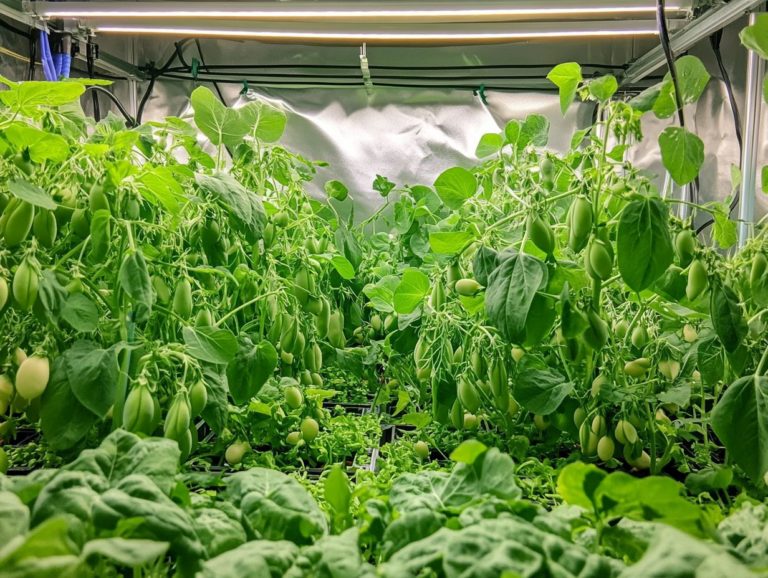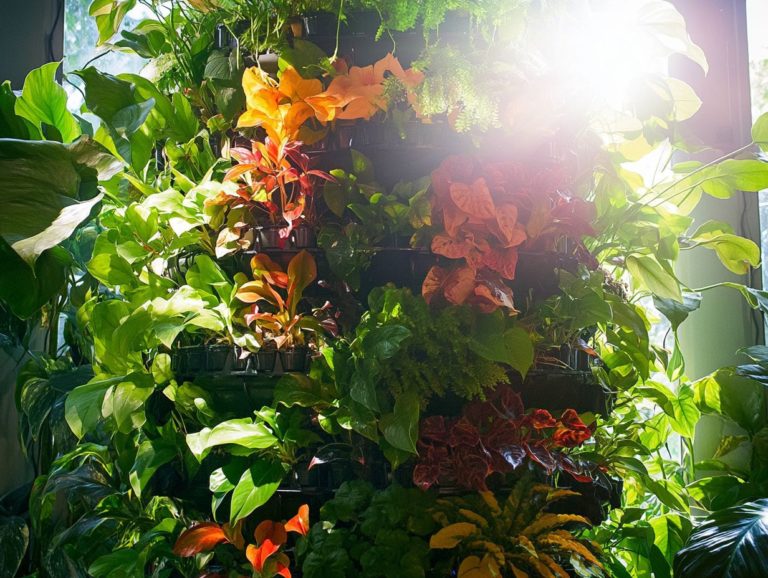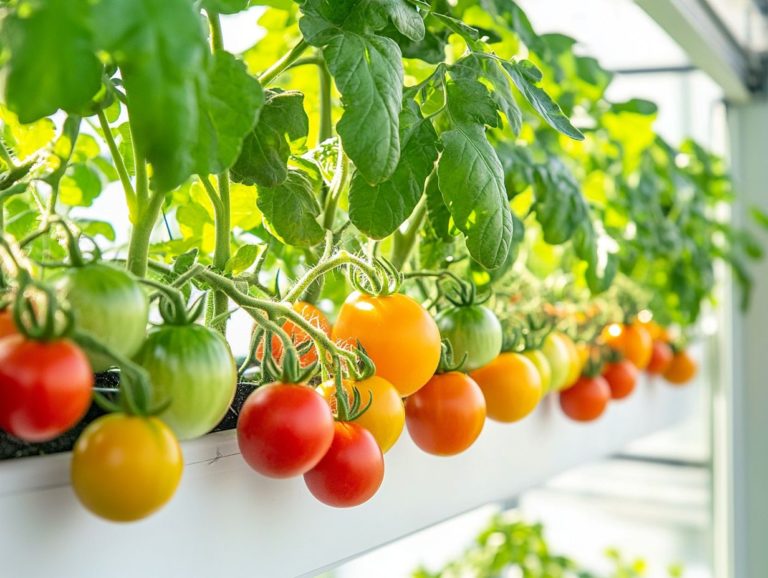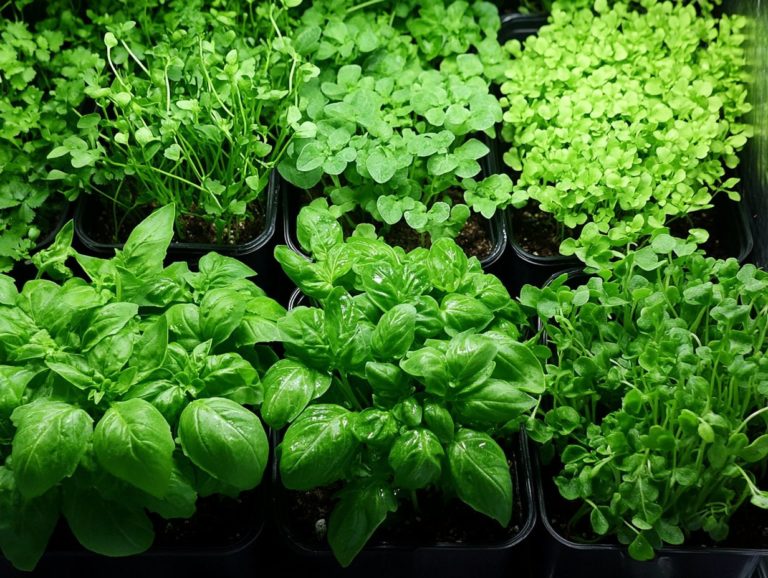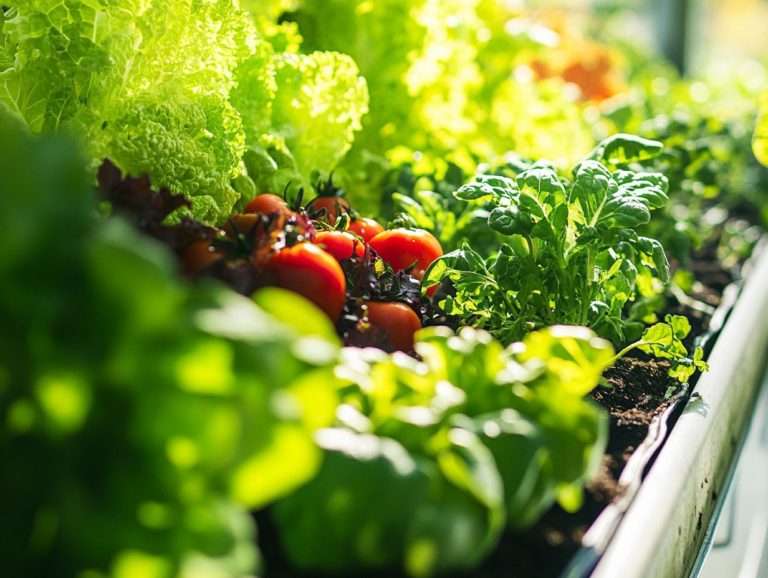“Top 10 Varieties of Hydroponic Squash”
Squash enthusiasts, get ready to celebrate! This article delves into the top 10 hydroponic squash varieties that can take your culinary creations and gardening skills to new heights.
From the ever-versatile zucchini to the delectable sweetness of butternut squash, each variety offers its own distinctive flavors and textures that will elevate your dishes.
You ll uncover the myriad benefits of hydroponic growing, including nutritional benefits and some challenges you might face along the way.
Whether you re an experienced gardener or an adventurous cook, there s a wealth of knowledge here for you to explore and enjoy!
Contents
- Key Takeaways:
- 1. Zucchini Squash
- 2. Yellow Squash
- 3. Pattypan Squash
- 4. Crookneck Squash
- 5. Butternut Squash
- 6. Spaghetti Squash
- 7. Acorn Squash
- 8. Delicata Squash
- 9. Scallop Squash
- 10. Hubbard Squash
- What Is Hydroponic Squash and How Is It Grown?
- Frequently Asked Questions
- What are the top 10 varieties of hydroponic squash?
- What makes these varieties suitable for hydroponic growing?
- Which variety is known for its unique shape?
- Are there any varietal differences in flavor among hydroponic squash?
- Do all of these varieties require the same growing conditions in a hydroponic system?
- Can these hydroponic squash varieties also be grown in traditional soil gardens?
Key Takeaways:
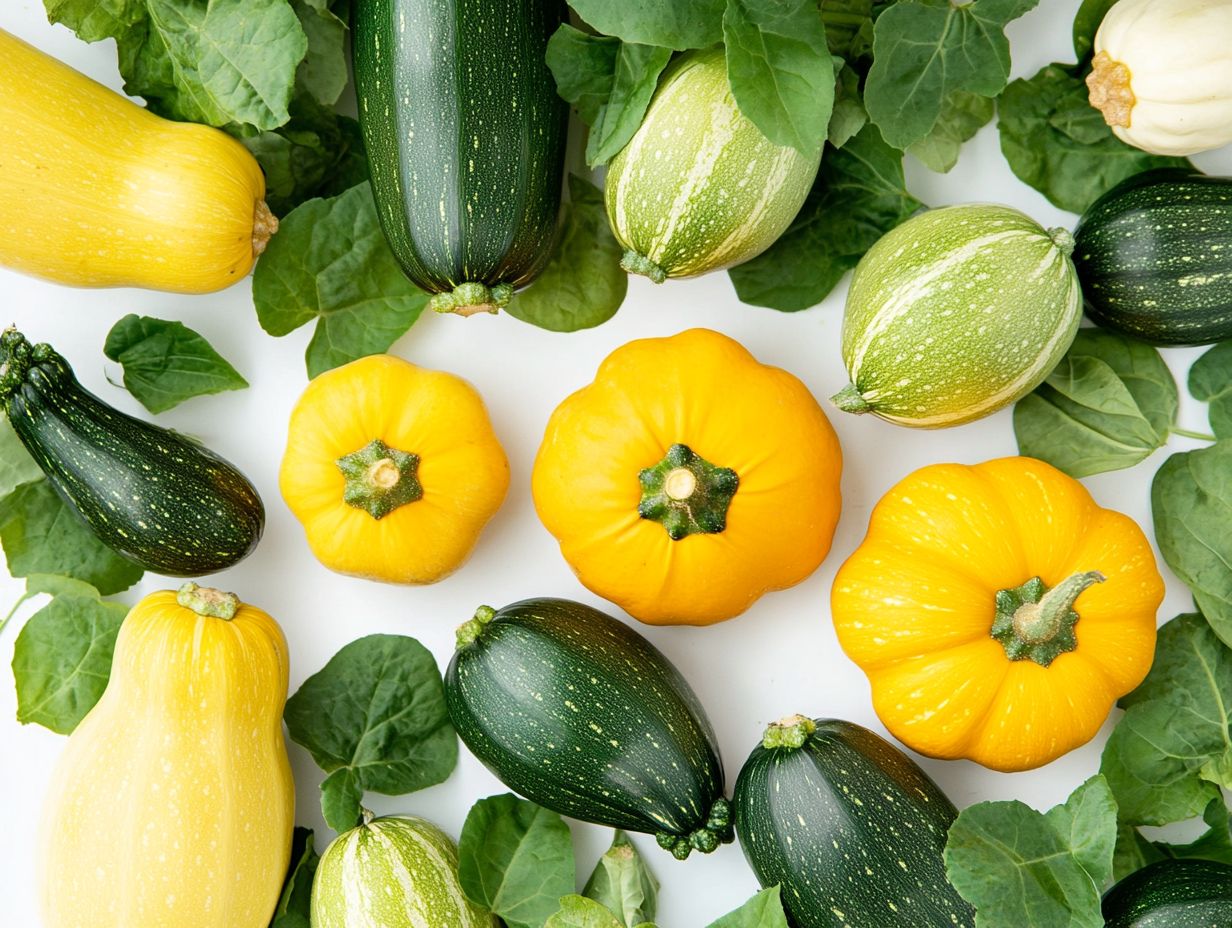
- Zucchini and yellow squash are popular varieties of hydroponic squash, known for their versatility and high yield.
- Pattypan and crookneck squash, both summer varieties, are also well-suited for hydroponic growing.
- Butternut and acorn squash, popular winter varieties, can be grown year-round using hydroponics techniques.
1. Zucchini Squash
Zucchini squash is a favored choice among indoor gardeners! It not only offers culinary versatility but also thrives in hydroponic systems. This method gives you a steady supply of fresh vegetables.
Using fertilizers specifically crafted for hydroponics, you can cultivate vibrant crops that are perfect for salads and various other dishes. Pairing these techniques with quality seeds from trusted sources like Sow Right Seeds makes growing zucchini rewarding and efficient.
These fertilizers deliver essential minerals that promote rapid growth and enhance flavor! Hydroponic zucchini flourishes in warm temperatures, receives plenty of light, and benefits from consistent watering, allowing for faster growth rates compared to traditional soil gardening.
This culinary gem shines in a multitude of recipes. Try adding zucchini to your next stir-fry for a delicious twist! It s an appealing option for health-conscious individuals aiming to incorporate more vegetables into their diets.
With the right techniques and resources, including those premium seeds from Sow Right Seeds, you can absolutely succeed in growing zucchini indoors.
2. Yellow Squash
Yellow squash is a delightful summer vegetable! It not only brightens up your dishes but also thrives in hydroponic setups, making it a fantastic option for anyone looking to cultivate fresh, healthy vegetables indoors.
This vibrant squash boasts smooth, tender skin and a mild flavor that pairs beautifully with a variety of culinary creations. With its high water content, fiber, and essential vitamins like A and C, yellow squash offers a wealth of nutritional benefits that can elevate your meals.
Hydroponic cultivation can significantly boost growth rates and flavor, allowing for optimal nutrient absorption. By using fertilizers that contain calcium and magnesium and ensuring a balanced pH, you ll ensure robust development and enhanced taste, transforming your home-grown squash into a true gourmet delight.
3. Pattypan Squash
Pattypan squash, with its charming shape and delicate flavor, makes a delightful addition to your hydroponic garden! It allows you to savor fresh, healthy vegetables all year round.
To cultivate this vibrant squash successfully, pay close attention to your nutrient solutions. These plants thrive in nutrient-rich water, requiring a balanced blend of nitrogen, phosphorus, and potassium to support their robust growth.
Pattypan squash loves well-lit environments; ideally, provide 12 to 14 hours of light daily to replicate its natural habitat.
In the kitchen, the versatility of pattypan squash truly shines. You can saut , grill, or even stuff it with savory mixtures. Incorporating pattypan squash into your stir-fries, casseroles, and salads not only elevates the flavor but also adds delightful visual appeal to your dishes.
Ready to grow your own hydroponic squash? Start today and enjoy fresh veggies in no time!
4. Crookneck Squash
Discover the delightful world of Crookneck Squash! Crookneck squash, with its charmingly curved neck, flourishes in hydroponic systems, providing a nutritious and flavorful choice for your indoor gardening.
This vibrant yellow squash isn’t just a feast for the eyes. It features tender, sweet flesh with a subtly nutty flavor, making it versatile for various dishes.
To grow well, utilize a nutrient solution with plenty of nitrogen, potassium, and phosphorus, which help plants grow strong. These key elements help with leaf growth and larger fruit.
When the moment arrives to harvest, keep an eye out for squashes that are firm with a glossy exterior, typically ready when they reach about six to eight inches in length. In the kitchen, crookneck squash can be saut ed, grilled, or tossed into salads, providing a delightful texture and sweetness that elevate any meal to new heights.
5. Butternut Squash
Butternut squash is a nutrient-dense gem that you can successfully cultivate in hydroponic systems, offering a delightful source of vitamins and flavor for your indoor gardening.
This vibrant squash is brimming with essential nutrients, including vitamins A, C, and E, along with potassium and dietary fiber, elevating both your health and culinary experiences.
When growing butternut squash hydroponically, it’s vital to employ well-balanced nutrient solutions that provide the necessary elements for robust growth and the development of its naturally sweet flavor.
Closely monitor pH levels (the acidity or alkalinity of the growing environment) and ensure that nutrients are consistently available. Adopting best practices like regular system maintenance and selecting the right growing medium will further enhance your cultivation efforts, making butternut squash an exceptional choice for your indoor garden.
6. Spaghetti Squash
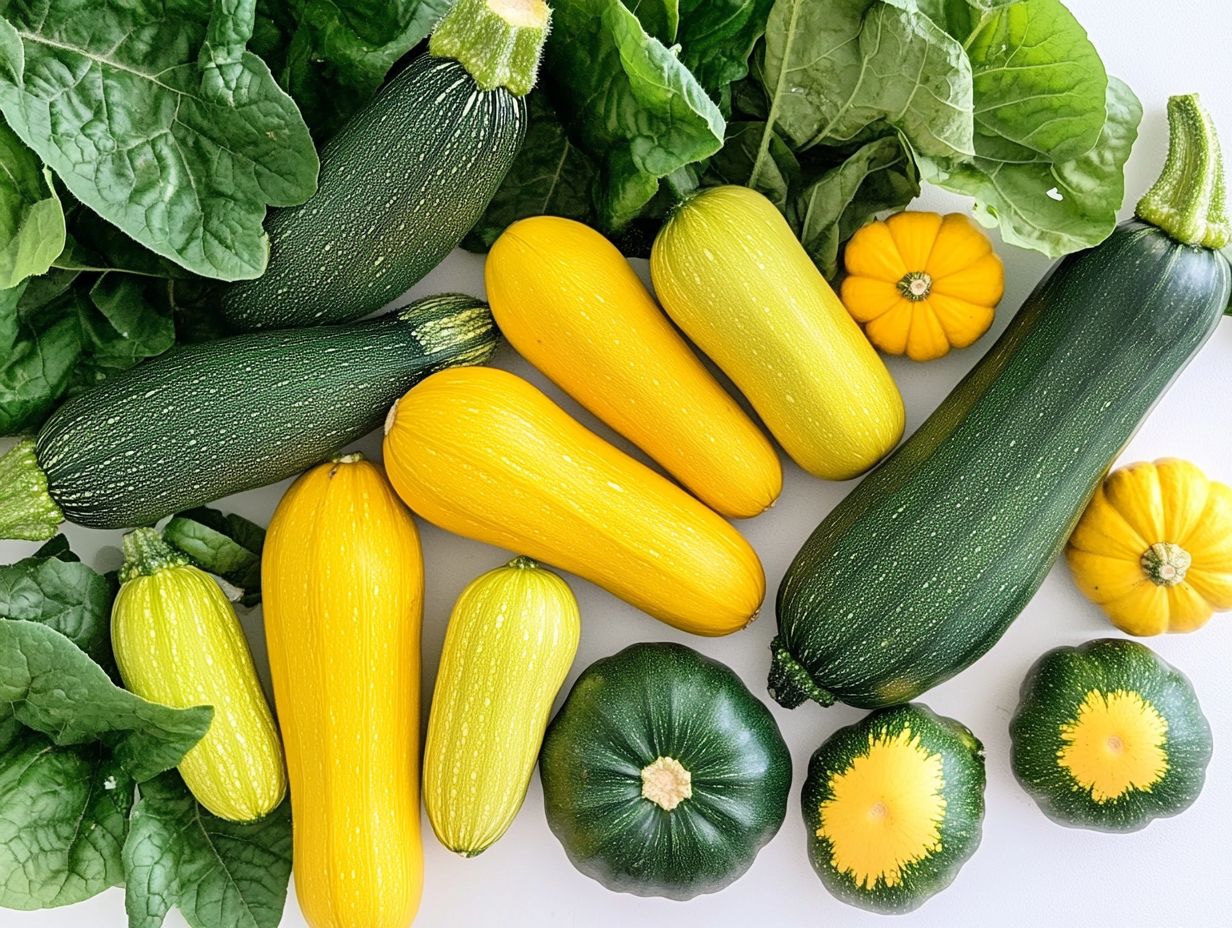
Spaghetti squash truly stands out in the garden with its unique stringy texture, and you ll find it remarkably easy to cultivate in hydroponic systems. This allows you to enjoy a nutritious vegetable alternative to pasta without much hassle.
For it to thrive in hydroponic conditions, aim for about 12 to 14 hours of light daily, best provided by full-spectrum LED grow lights that replicate natural sunlight. Keeping the temperature between 70 and 85 degrees Fahrenheit will ensure optimal growth.
A nutrient solution rich in nitrogen, potassium, and phosphorus is crucial for achieving robust yields. As a culinary gem, spaghetti squash makes for a fantastic low-carb substitute for traditional pasta.
It adapts beautifully to a range of dishes, from savory casseroles to zesty salads, making it an enticing choice for those who prioritize health in their eating habits.
7. Acorn Squash
Acorn squash, with its delightful sweet and nutty flavor, is a prime choice for hydroponic gardening, allowing you to cultivate healthy vegetables that are bursting with flavor and essential nutrients.
This vibrant squash isn t just a feast for the taste buds. Its striking green and orange hues make it visually appealing as well.
Its versatility in the kitchen is unmatched you can roast, stuff, or puree it, making it a staple in countless seasonal recipes. When diving into hydroponic cultivation, it’s essential to focus on the nutrient solutions that will nurture its growth.
Creating the ideal conditions means maintaining consistent moisture and a well-balanced mix of nitrogen, phosphorus, and potassium tailored to the plant’s lifecycle. By adeptly managing these growth conditions, you can indulge in generous yields of this delectable squash all year round.
8. Delicata Squash
Delicata squash is a treasured ingredient known for its creamy texture and sweet taste. It s perfect for your hydroponic garden.
In a controlled environment, it thrives beautifully with a special liquid that helps plants grow. By embracing hydroponics, you can optimize space efficiency, allowing for a remarkably bountiful yield even in compact areas.
The consistent supply of nutrients and water elevates the flavor profile of the squash, resulting in an incredibly sweet and tender vegetable. For optimal harvesting, wait until the skin feels firm and the color deepens, a sure sign of maturity.
In the kitchen, this versatile squash truly shines, whether it s roasted, stuffed, or featured in dishes that showcase its naturally sweet flavor. It s effortlessly integrated into soups and salads, establishing itself as a staple ingredient in any garden enthusiast’s culinary repertoire.
9. Scallop Squash
Scallop squash, known for its distinctive shape and culinary versatility, is a remarkable candidate for hydroponic systems. Enjoy fresh scallop squash right at home.
This squash loves nutrient-rich solutions and thrives at warm temperatures between 70 F and 85 F. Pair it with consistent moisture and ample light for excellent indoor gardening.
Scallop squash can be saut ed, grilled, or stuffed. Its delightful texture and mild flavor enhance various dishes, from roasted squash salads to creamy soups.
10. Hubbard Squash
Hubbard squash is known for its dense and sweet flesh. It s an excellent choice for year-round hydroponic cultivation, enabling you to produce flavorful, healthy vegetables.
This remarkable squash variety not only boasts a rich, buttery taste but also offers a robust texture that makes it versatile for soups, stews, and baked dishes. When you decide to grow it hydroponically, paying attention to detail is crucial.
Utilizing a meticulously balanced nutrient solution enhances both the flavor and yield of your Hubbard squash. Incorporate essential elements like nitrogen, phosphorus, and potassium to encourage healthy growth.
Adjusting pH levels, which is a measure of how acidic or basic a solution is, and ensuring the right light duration are vital practices. These create the perfect environment for your plants to thrive, leading to a bountiful harvest of delicious squash.
What Is Hydroponic Squash and How Is It Grown?
Hydroponic squash includes varieties like zucchini and butternut, cultivated in nutrient-rich solutions that eliminate the need for soil. This method leads to faster growth and tastier squash.
This innovative gardening approach employs a precisely balanced nutrient solution that delivers essential minerals directly to the roots. This boosts nutrient absorption and promotes robust growth.
By fine-tuning factors like pH and electrical conductivity, hydroponics creates an ideal environment for squash plants, resulting in quicker maturation and bolder flavors.
Among the popular hydroponic squash varieties are yellow squash and acorn squash, each requiring tailored light conditions and temperatures to thrive. For instance, zucchini flourishes in bright light and warmth, while butternut squash prefers slightly cooler settings.
This versatility showcases how hydroponics can adapt to meet the diverse needs of different plants. Don t miss out on the chance to grow delicious squash all year round!
What Are the Benefits of Growing Squash Hydroponically?
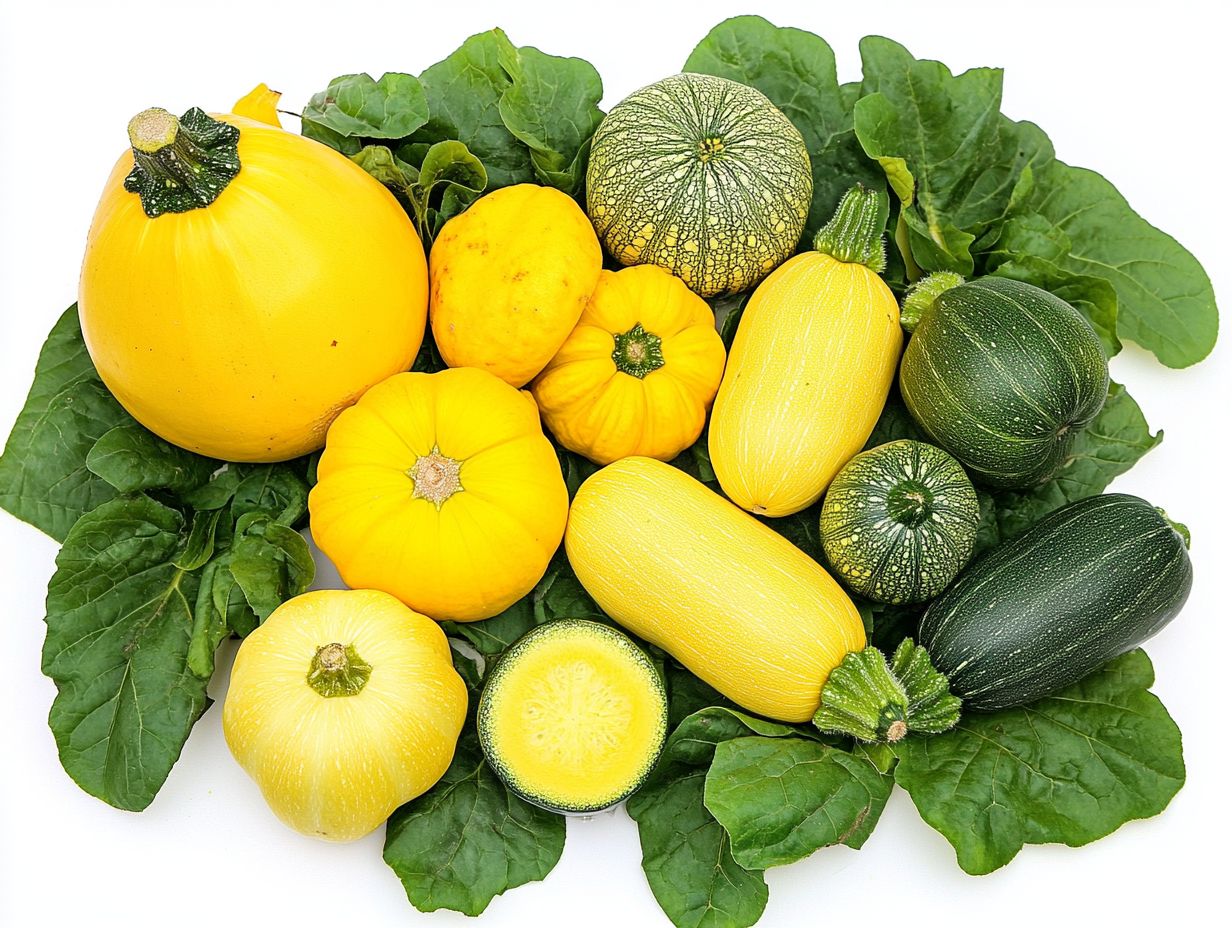
Growing squash hydroponically offers many advantages. You can enjoy impressive yields and accelerated growth rates, all while cultivating vibrant vegetables in limited spaces perfect for indoor gardening enthusiasts.
This innovative approach conserves water, an important advantage in today’s resource-conscious world. By employing a closed-loop system, which recirculates water and nutrients, hydroponics minimizes waste and allows you to tailor nutrient solutions to meet your squash plants’ specific needs.
Indoor environments protect crops from common pests and diseases. This eliminates the reliance on harmful pesticides and fosters a more sustainable growing practice. Plus, with the ability to control light and temperature, your squash can thrive year-round, ensuring a steady supply regardless of unpredictable outdoor conditions and optimizing your harvest cycles.
How Can Different Varieties of Squash Be Grown Hydroponically?
Many varieties of squash, including zucchini, acorn, and spaghetti, thrive in hydroponic systems. Each type has unique requirements for nutrient solutions and environmental conditions.
For example, zucchini loves full sunlight and thrives best in temperatures from 70 F to 85 F. To maximize your success, focus on well-balanced nutrient solutions rich in nitrogen and potassium.
Acorn squash is more forgiving with cooler temperatures but still needs good light. It benefits from a higher phosphorus concentration to promote fruit development. Spaghetti squash, on the other hand, craves consistent warmth and a full day of light for optimal growth. Ensure you provide a balanced mix of macro and micronutrients to support its vigorous vine structure.
By employing techniques like nutrient film technique (NFT) or deep water culture (DWC), you can enhance the efficiency of water and nutrients, helping these squash varieties reach their full potential in your hydroponic setup.
What Are the Nutritional Benefits of Hydroponic Squash?
Hydroponic squash is not just a treat for your taste buds; it’s full of nutritional benefits that elevate your diet.
Rich in vitamin A for vision and immune function, and vitamin C for collagen production and antioxidant protection, different squash types also provide significant fiber content to aid digestion. Varieties like zucchini and butternut squash are recognized for their heart-healthy nutrients.
Utilizing hydroponic cultivation methods enhances these nutritional profiles. These methods optimize growth conditions, enabling plants to absorb water and nutrients efficiently. As a result, squash from these environments tends to have elevated levels of antioxidants, making it a supercharged addition to your meals.
How Can Hydroponic Squash Be Incorporated into Recipes?
Hydroponic squash is a versatile ingredient that can elevate a variety of recipes, from fresh salads to hearty casseroles. It adds flavor while packing in nutrition, showcasing the benefits of freshly grown, wholesome vegetables.
This unique variety thrives in nutrient-rich environments, delivering a delightful crunch and subtle sweetness that can transform both casual meals and gourmet creations. When using hydroponic squash, consider grilling or roasting it to bring out its rich flavors, or even spiralizing it for a light, gluten-free pasta substitute.
Whether tossed into a vibrant salad, blended into a creamy soup, or layered in a comforting lasagna, this squash opens the door to endless culinary possibilities. A sprinkle of herbs or spices can beautifully enhance its natural taste, making it a beloved choice for both novice cooks and seasoned chefs.
Ready to try growing your own hydroponic squash? Start today to enjoy fresh, nutritional benefits all year round!
What Are the Potential Challenges of Growing Squash Hydroponically?
Growing squash hydroponically is rewarding. However, you should know about the challenges involved, such as managing nutrient solutions, dealing with pests, and maintaining the right environmental conditions.
You may find yourself wrestling with nutrient imbalances, which can lead to underdeveloped or discolored plants. Pests like aphids and spider mites might try to crash the party, requiring effective control strategies.
Monitor the pH regularly. Ensuring your plants receive the right balance of nutrients is essential, including checking the electrical conductivity (EC) levels to measure the strength of the nutrient solution.
Implementing pest control methods, such as introducing beneficial insects or utilizing organic insecticides, is vital in keeping unwelcome guests at bay. Stay vigilant and adjust quickly to cultivate a thriving hydroponic setup that guarantees a bountiful harvest!
Frequently Asked Questions
What are the top 10 varieties of hydroponic squash?
- Zucchini
- Yellow straightneck
- Yellow crookneck
- Pattypan
- Acorn
- Butternut
- Spaghetti
- Delicata
- Kabocha
- Hubbard
The top 10 varieties of hydroponic squash include the ones listed above.
What makes these varieties suitable for hydroponic growing?
These varieties are suitable because they have compact growth habits, require less space, and produce high yields in a controlled environment.
Which variety is known for its unique shape?
Pattypan squash is known for its unique saucer-like shape, making it a popular choice for visual appeal in hydroponic systems.
Are there any varietal differences in flavor among hydroponic squash?
Yes, there can be slight varietal differences in flavor among hydroponic squash. Some varieties may taste sweeter or nuttier compared to others.
Do all of these varieties require the same growing conditions in a hydroponic system?
While all these varieties can be grown in a hydroponic system, each may have slightly different environmental preferences, such as temperature and pH levels.
Can these hydroponic squash varieties also be grown in traditional soil gardens?
Yes, all of these varieties are suitable for traditional soil gardens as well, but they may require more space and maintenance compared to hydroponic growing.
Start your hydroponic adventure now! Choose your squash variety today!

